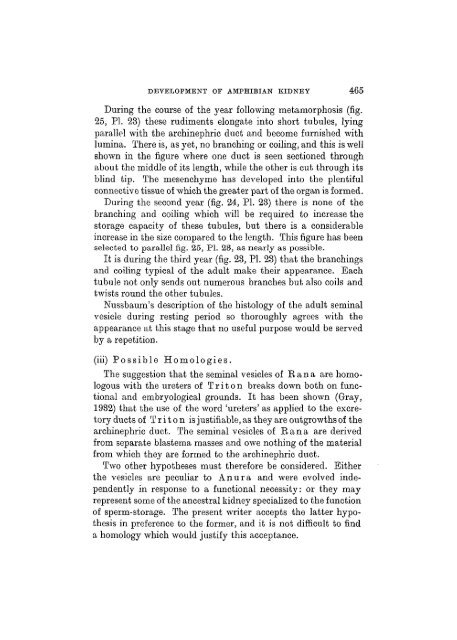ment of the Kidney, and the Development of the - Journal of Cell ...
ment of the Kidney, and the Development of the - Journal of Cell ...
ment of the Kidney, and the Development of the - Journal of Cell ...
Create successful ePaper yourself
Turn your PDF publications into a flip-book with our unique Google optimized e-Paper software.
DEVELOPMENT OF AMPHIBIAN KIDNEY 465<br />
During <strong>the</strong> course <strong>of</strong> <strong>the</strong> year following metamorphosis (fig.<br />
25, PI. 23) <strong>the</strong>se rudi<strong>ment</strong>s elongate into short tubules, lying<br />
parallel with <strong>the</strong> archinephric duct <strong>and</strong> become furnished with<br />
lumina. There is, as yet, no branching or coiling, <strong>and</strong> this is well<br />
shown in <strong>the</strong> figure where one duct is seen sectioned through<br />
about <strong>the</strong> middle <strong>of</strong> its length, while <strong>the</strong> o<strong>the</strong>r is cut through its<br />
blind tip. The mesenchyme has developed into <strong>the</strong> plentiful<br />
connective tissue <strong>of</strong> which <strong>the</strong> greater part <strong>of</strong> <strong>the</strong> organ is formed.<br />
During <strong>the</strong> second year (fig. 24, PI. 23) <strong>the</strong>re is none <strong>of</strong> <strong>the</strong><br />
branching <strong>and</strong> coiling which will be required to increase <strong>the</strong><br />
storage capacity <strong>of</strong> <strong>the</strong>se tubules, but <strong>the</strong>re is a considerable<br />
increase in <strong>the</strong> size compared to <strong>the</strong> length. This figure has been<br />
selected to parallel fig. 25, PI. 23, as nearly as possible.<br />
It is during <strong>the</strong> third year (fig. 23, PL 23) that <strong>the</strong> branchings<br />
<strong>and</strong> coiling typical <strong>of</strong> <strong>the</strong> adult make <strong>the</strong>ir appearance. Each<br />
tubule not only sends out numerous branches but also coils <strong>and</strong><br />
twists round <strong>the</strong> o<strong>the</strong>r tubules.<br />
Nussbaum's description <strong>of</strong> <strong>the</strong> histology <strong>of</strong> <strong>the</strong> adult seminal<br />
vesicle during resting period so thoroughly agrees with <strong>the</strong><br />
appearance at this stage that no useful purpose would be served<br />
by a repetition.<br />
(iii) Possible Homologies.<br />
The suggestion that <strong>the</strong> seminal vesicles <strong>of</strong> E a n a are homologous<br />
with <strong>the</strong> ureters <strong>of</strong> Triton breaks down both on functional<br />
<strong>and</strong> embryological grounds. It has been shown (Gray,<br />
1932) that <strong>the</strong> use <strong>of</strong> <strong>the</strong> word 'ureters' as applied to <strong>the</strong> excretory<br />
ducts <strong>of</strong> Triton is justifiable, as <strong>the</strong>y are outgrowths <strong>of</strong> <strong>the</strong><br />
archinephric duct. The seminal vesicles <strong>of</strong> Eana are derived<br />
from separate blastema masses <strong>and</strong> owe nothing <strong>of</strong> <strong>the</strong> material<br />
from which <strong>the</strong>y are formed to <strong>the</strong> archinephric duct.<br />
Two o<strong>the</strong>r hypo<strong>the</strong>ses must <strong>the</strong>refore be considered. Ei<strong>the</strong>r<br />
<strong>the</strong> vesicles are peculiar to Anura <strong>and</strong> were evolved independently<br />
in response to a functional necessity: or <strong>the</strong>y may<br />
represent some <strong>of</strong> <strong>the</strong> ancestral kidney specialized to <strong>the</strong> function<br />
<strong>of</strong> sperm-storage. The present writer accepts <strong>the</strong> latter hypo<strong>the</strong>sis<br />
in preference to <strong>the</strong> former, <strong>and</strong> it is not difficult to find<br />
a homology which would justify this acceptance.
















